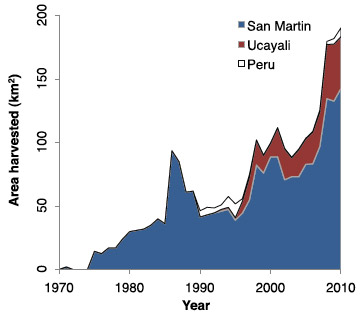Intensive palm oil production is expanding at the expense of biolologically-rich lowland rainforests in the Peruvian Amazon, reports a study published in Environmental Research Letters. The research indicates that enthusiasm for oil palm — one of the world’s most lucrative crops — is taking a toll on forests outside of Southeast Asia, where the vast majority of palm oil is produced.
The analysis, based on satellite mapping and on-the-ground field studies, found that 72 percent of new plantations in Peru expanded into forest areas. Expansion into forest areas was more common with industrial plantations, rather than low-yield plantations established by smallholders.
 Total oil palm cultivation area in the regions of San Martin and Ucayali in Peru, which account for 98 percent of oil palm extent in Peru. Deforestation for palm oil production accounted for 1.3 percent of Peru’s total forest loss between 2000 and 2010.
|
“Low-yield plantations accounted for most expansion overall (80%), but only 30% of their expansion involved forest conversion, contrasting with 75% for high-yield expansion,” wrote the authors, referring to data from a focus area in the Ucayali region.
The findings indicate that contrary to claims sometimes advanced by the palm oil industry, intensification is not helping reduce pressure on forests.
“The results show that high-yield agriculture is an important but insufficient strategy to reduce pressure on forests,” the authors write. “We suggest that high-yield agriculture can be effective in sparing forests only if coupled with incentives for agricultural expansion into already cleared lands.”
The researchers weren’t able to definitively determine why industrial plantations targets old-growth forest areas, but suggest — based on conversations with local residents — that disputes over already-cleared land are likely a factor.
“It is simpler to establish tenureship over forests, officially owned by the State,” they write. “Moreover, many high-yield plantations are owned by large, extra-local entities that choose not to engage with the local social and political complications that any land disputes might entail.”
In a global context, Peru is a minor palm oil producer. But over the past decade, the government has boosted incentives for production, including tax breaks and a biofuel target. The high profitability of the crop means expansion is expected to continue.
CITATION: Vıctor H Gutierrez-Velez, Ruth DeFries, Miguel Pinedo-Vasquez, Marıa Uriarte, Christine Padoch, Walter Baethgen, Katia Fernandes, and Yili Lim. High-yield oil palm expansion spares land at the expense of forests in the Peruvian Amazon. ENVIRONMENTAL RESEARCH LETTERS 6 (2011) 044029 (5pp) doi:10.1088/1748-9326/6/4/044029
Related articles















